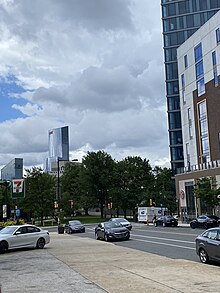Philadelphia and Lancaster Turnpike | |
|---|---|
| Route information | |
| Maintained by PennDOT | |
| Length | 73.33 mi[1] (118.01 km) Route to Columbia included (10.86 mi) |
| Existed | 1792 (first used 1795)–present |
| Component highways |
• SR 3012 and SR 3005 in Philadelphia • Lancaster Walk (a pedestrian walkway) at Drexel University campus between 34th and Market Streets |
| Major junctions | |
| West end | |
| East end | |
| Location | |
| Country | United States |
| State | Pennsylvania |
| Counties | Lancaster, Chester, Delaware, Montgomery, Philadelphia |
| Highway system | |
| Designated | November 20, 1999[2] |

The Philadelphia and Lancaster Turnpike, first used in 1795, is the first long-distance paved road built in the United States, according to engineered plans and specifications.[3] It links Lancaster, Pennsylvania, and Philadelphia at 34th Street, stretching for sixty-two miles. It was later extended by the Lancaster and Susquehanna Turnpike to the Susquehanna River in Columbia.[4] The route is now designated Pennsylvania Route 462 from the western terminus to US 30 just southeast of Lancaster, at which point US 30 (and US 30 Business in Chester County) follows the route to Philadelphia. The US 30 portion ends at Girard Avenue in the Parkside neighborhood of Philadelphia, where State Route 3012 is designated on the road to Belmont Avenue. At Belmont Avenue, the road changes designation to State Route 3005 and runs to the eastern terminus at 34th Street. Historically, Lancaster Pike terminated at Market Street before Drexel University took over the stretch between 32nd and 34th Streets and turned the road into a pedestrian walkway known as Lancaster Walk.[5]

It was the first turnpike of importance, and because the Commonwealth of Pennsylvania could not afford to pay for its construction, it was privately built by the Philadelphia and Lancaster Turnpike Road Company, making it an early example of a public-private partnership for American infrastructure.[6][7] Credited as the country's first engineered road, its ground was broken in 1792.[8] By the 1840s, the use of railroads and canals dealt a serious blow to the companies who specialized in the manufacture of wagons and coaches. During the next fifty years, the road suffered from lack of use and maintenance, but later saw recovery with the invention of the automobile.

In 1876, the parallel Pennsylvania Railroad bought the turnpike from 52nd Street in Philadelphia west to Paoli for $20,000 (equal to $572,250 today) to prevent competing streetcar companies from building along it. In 1913, the turnpike became part of the transcontinental Lincoln Highway, and tolls continued to be collected until 1917, when the State Highway Department bought it for $165,000, equal to $3,924,000 today.[9] In 1926 it was designated as part of U.S. Route 30 along with the rest of the original United States Numbered Highways.
- ^ DeLorme Street Atlas 2007, Toggle Measure Tool. Retrieved on July 2, 2007.
- ^ "PHMC Historical Markers Search" (Searchable database). Pennsylvania Historical and Museum Commission. Commonwealth of Pennsylvania. Retrieved January 25, 2014.
- ^ "The Philadelphia and Lancaster Turnpike Road". Federal Highway Administration. Retrieved May 29, 2006.
- ^ "Bridges, Roads, and Turnpikes Collection, 1767-1968". LancasterHistory. Retrieved December 10, 2020.
- ^ Philadelphia County (PDF) (Map). Pennsylvania Department of Transportation. 2005. p. 1. Retrieved July 2, 2007.[permanent dead link]
- ^ Buxbaum, Jeffrey N (2009). Public Sector Decision Making for Public-private Partnerships. Washington, DC: Transportation Research Board. p. 9. ISBN 978-0-309-09829-8.
- ^ "Philadelphia & Lancaster Turnpike". Lifelong Learning Online. Archived from the original on August 27, 2002. Retrieved May 29, 2006.
- ^ "Philadelphia & Lancaster Turnpike". Explore Pennsylvania History. Retrieved May 29, 2006.
- ^ Butko, Brian. The Lincoln Highway: Pennsylvania Traveler's Guide. pp. 50–51. ISBN 0-8117-2497-2.